
Euphorbia is a very large and diverse genus of flowering plants, commonly called spurge, in the family Euphorbiaceae. "Euphorbia" is sometimes used in ordinary English to collectively refer to all members of Euphorbiaceae, not just to members of the genus.

The calandra lark or European calandra-lark breeds in warm temperate countries around the Mediterranean and eastwards through Turkey into northern Iran and southern Russia. It is replaced further east by its relative, the bimaculated lark.

The Zagros Mountains are a long mountain range in Iran, northern Iraq, and southeastern Turkey. This mountain range has a total length of 1,600 km (990 mi). The Zagros mountain range begins in northwestern Iran and roughly follows Iran's western border while covering much of southeastern Turkey and northeastern Iraq. From this border region, the range continues to the southeast under also the waters of the Persian Gulf. It spans the southern parts of the Armenian highland, the whole length of the western and southwestern Iranian plateau, ending at the Strait of Hormuz. The highest point is Mount Dena, at 4,409 metres (14,465 ft).

Peganum harmala, commonly called wild rue, Syrian rue, African rue, esfand or espand, or harmel, is a perennial, herbaceous plant, with a woody underground rootstock, of the family Nitrariaceae, usually growing in saline soils in temperate desert and Mediterranean regions. Its common English-language name came about because of a resemblance to rue. Because eating it would sicken or kill livestock, it is considered a noxious weed in a number of countries. It has become an invasive species in some regions of the western United States. The plant is popular in Middle Eastern and north African folk medicine. The alkaloids contained in the plant, including the seeds, are monoamine oxidase inhibitors.
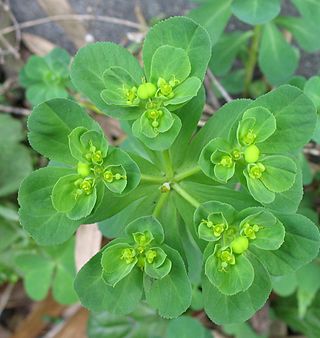
Euphorbia helioscopia, the sun spurge or madwoman's milk, is a species of flowering plant in the spurge family Euphorbiaceae. It is a herbaceous annual plant, native to most of Europe, northern Africa, and eastward through most of Asia.
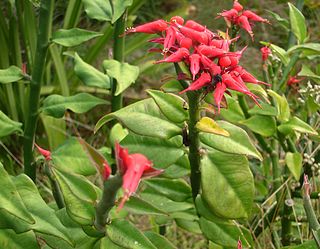
Euphorbia tithymaloides is a perennial succulent spurge. An erect shrub, the plant is also known by the scientific name Pedilanthus tithymaloides. However, the genus Pedilanthus has been submerged into the genus Euphorbia, and is more correctly known by its new name.

Euphorbia corollata is an herbaceous perennial plant in the family Euphorbiaceae that is native to North America. A common name for the species is flowering spurge. It has a milky sap that can cause skin and eye irritation in some people. It grows up to 1 m (3 ft) tall, with smooth stems and light green leaves arranged alternately or in whorls. Leaves are about 10 mm wide and 75 mm (3 in) long. Each stem terminates in a panicle 20 to 25 mm across. Flowers are about 6 mm across and consist of one pistillate and several staminate flowers surrounded by five white bracts - not petals but formed from the involucre at the base of the flowers. Flowering spurge blooms from June to September.

Euphorbiaceae, the spurge family, is a large family of flowering plants. In English, they are also commonly called euphorbias, which is also the name of the type genus of the family. Most spurges, such as Euphorbia paralias, are herbs, but some, especially in the tropics, are shrubs or trees, such as Hevea brasiliensis. Some, such as Euphorbia canariensis, are succulent and resemble cacti because of convergent evolution. This family has a cosmopolitan global distribution. The greatest diversity of species is in the tropics; however, the Euphorbiaceae also have many species in nontropical areas of all continents except Antarctica.
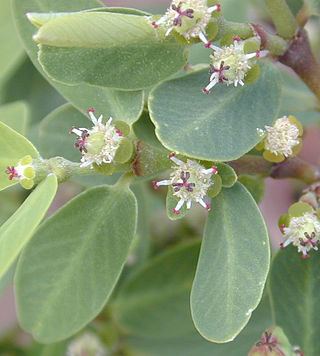
Euphorbia celastroides is a flowering plant in the family Euphorbiaceae. It is referred to by the common name 'akoko by Hawaiians, and is a species of spurge closely related to the poinsettia. This species develops into a round-shape shrub. This species is endemic to the Hawaiian Islands.

Sclerocroton integerrimus, the duiker berry, is a tree in the family Euphorbiaceae, from Southern Africa.

Euphorbia royleana is a species of flowering plant in the family Euphorbiaceae. It is also known as Sullu spurge, and Royle's spurge. It is a succulent and almost cactus like in appearance although unrelated. It grows right across the Himalaya mountains from Pakistan, India, Bhutan, Myanmar, Nepal to western China, It prefers dry and rocky slopes between 1000 and 1500 meters, but has been found up to 2000 meters. Flowering and fruiting is in spring to early summer (March–July) and seeding is in June–October. It is used as a hedging plant in northern India and has medicinal uses.

Euphorbia schinzii is a perennial Southern African, dwarf flowering plant belonging to the family Euphorbiaceae. It is found on rocky slopes, growing among rocks. Variable in form, it occurs in South Africa, Zimbabwe, Botswana, Mozambique and Malawi, at an altitude between 100 and 1500 meters. The genus Euphorbia is large, with over 2000 species of extremely diverse size and appearance, and with a global distribution.
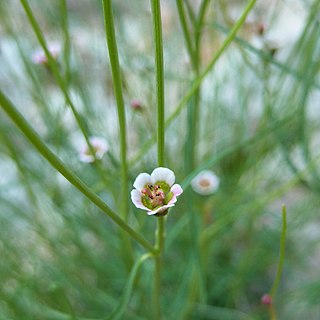
Euphorbia aaron-rossii, also known as the Marble Canyon spurge, is a perennial, herbaceous plant species of Euphorbia native to Arizona. It's most closely related to E. strictior and E. wrightii, but needs more study.

Hypericum sechmenii, or Seçmen's St John's wort, is a rare species of flowering plant of the St John's wort family (Hypericaceae) that is found in the Eskişehir Province of central Turkey. It was first described in 2009 by Turkish botanists Atila Ocak and Onur Koyuncu, who named the species in honor of Özcan Seçmen, a fellow botanist. They assigned the species to the genus Hypericum, and Norman Robson later placed H. sechmenii into section Adenosepalum. It is a perennial herb which grows in clusters of stems 3–6 centimetres (cm) tall and blooms in June and July. The stems of the plant are smooth and lack hairs, while the leaves are leathery and do not have leafstalks. Its flowers are arranged in clusters that form a flat-topped shape known as a corymb, and each flower possesses five bright yellow petals. There are several species that are similar in appearance to H. sechmenii, with only minor physical differences that set them apart. The most closely related of these are Hypericum huber-morathii, H. minutum, and H. thymopsis.
Fontainea borealis is a small tree endemic to Papua New Guinea, in the family, Euphorbiaceae, which grows to a height of 12 m.
Fontainea subpapuana is a small tree endemic to Papua New Guinea in the family, Euphorbiaceae, which grows to a height of 7 m.
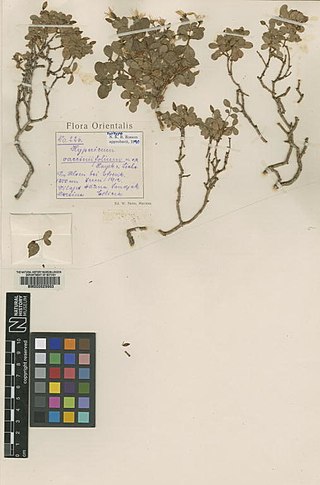
Hypericum vacciniifolium is a species of flowering plant in the flowering plant family Hypericaceae. It was first described by August von Hayek and Walter Siehe in the Ann. K. K. Naturhist. Hofmus. journal in 1914 from a specimen collected by Siehe in 1912.
Euphorbia pedroi is a species of flowering plant in the spurge family endemic to the Arrábida Natural Park in Portugal. It is part of section Aphyllis, a mostly African and Macaronesian clade, being the only member of its section native to Europe. Its binomial name is dedicated to José Gomes Pedro (1915-2010) a Portuguese botanist, who studied the flora and vegetation of Arrábida and Mozambique.
Euphorbia hierosolymitana is a shrubby plant species with two varieties.
Euphorbia taurinensis is a species of flowering plant in the family Euphorbiaceae.














